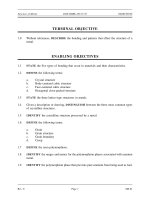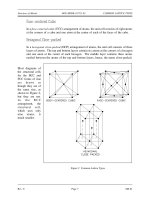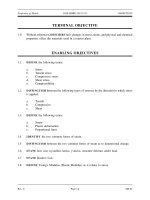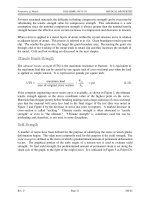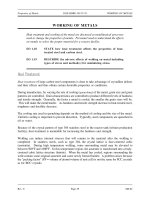Material Science_ Vol 1 of 2 - US DOE (1993) WW Part 10 docx
Bạn đang xem bản rút gọn của tài liệu. Xem và tải ngay bản đầy đủ của tài liệu tại đây (211.31 KB, 8 trang )
Properties of Metals DOE-HDBK-1017/1-93 PHYSICAL PROPERTIES
For most structural materials, the difficulty in finding compressive strength can be overcome by
substituting the tensile strength value for compressive strength. This substitution is a safe
assumption since the nominal compression strength is always greater than the nominal tensile
strength because the effective cross section increases in compression and decreases in tension.
When a force is applied to a metal, layers of atoms within the crystal structure move in relation
to adjacent layers of atoms. This process is referred to as slip. Grain boundaries tend to prevent
slip. The smaller the grain size, the larger the grain boundary area. Decreasing the grain size
through cold or hot working of the metal tends to retard slip and thus increases the strength of
the metal. Cold and hot working are discussed in the next chapter.
The ultimate tensile strength (UTS) is the maximum resistance to fracture. It is equivalent to
the maximum load that can be carried by one square inch of cross-sectional area when the load
is applied as simple tension. It is expressed in pounds per square inch.
UTS = = psi (2-12)
maximum load
area of original cross section
P
max
A
o
If the complete engineering stress-strain curve is available, as shown in Figure 3, the ultimate
tensile strength appears as the stress coordinate value of the highest point on the curve.
Materials that elongate greatly before breaking undergo such a large reduction of cross-sectional
area that the material will carry less load in the final stages of the test (this was noted in
Figure 3 and Figure 4 by the decrease in stress just prior to rupture). A marked decrease in
cross-section is called "necking." Ultimate tensile strength is often shortened to "tensile
strength" or even to "the ultimate." "Ultimate strength" is sometimes used but can be
misleading and, therefore, is not used in some disciplines.
A number of terms have been defined for the purpose of identifying the stress at which plastic
deformation begins. The value most commonly used for this purpose is the yield strength. The
yield strength is defined as the stress at which a predetermined amount of permanent deformation
occurs. The graphical portion of the early stages of a tension test is used to evaluate yield
strength. To find yield strength, the predetermined amount of permanent strain is set along the
strain axis of the graph, to the right of the origin (zero). It is indicated in Figure 5 as Point (D).
Rev. 0 Page 21 MS-02
PHYSICAL PROPERTIES DOE-HDBK-1017/1-93 Properties of Metal
A straight line is drawn through Point (D)
Figure 5 Typical Brittle Material Stress-Strain Curve
at the same slope as the initial portion of
the stress-strain curve. The point of
intersection of the new line and the stress-
strain curve is projected to the stress axis.
The stress value, in pounds per square
inch, is the yield strength. It is indicated
in Figure 5 as Point 3. This method of
plotting is done for the purpose of
subtracting the elastic strain from the total
strain, leaving the predetermined
"permanent offset" as a remainder. When
yield strength is reported, the amount of
offset used in the determination should be
stated. For example, "Yield Strength (at
0.2% offset) = 51,200 psi."
Some examples of yield strength for metals are as follows.
Aluminum 3.5 x 10
4
to 4.5 x 10
4
psi
Stainless steel 4.0 x 10
4
to 5.0 x 10
4
psi
Carbon steel 3.0 x 10
4
to 4.0 x 10
4
psi
Alternate values are sometimes used instead of yield strength. Several of these are briefly
described below.
The yield point, determined by the divider method, involves an observer
with a pair of dividers watching for visible elongation between two gage
marks on the specimen. When visible stretch occurs, the load at that
instant is recorded, and the stress corresponding to that load is calculated.
MS-02 Page 22 Rev. 0
Properties of Metals DOE-HDBK-1017/1-93 PHYSICAL PROPERTIES
Soft steel, when tested in tension, frequently displays a peculiar
characteristic, known as a yield point. If the stress-strain curve is plotted,
a drop in the load (or sometimes a constant load) is observed although the
strain continues to increase. Eventually, the metal is strengthened by the
deformation, and the load increases with further straining. The high point
on the S-shaped portion of the curve, where yielding began, is known as
the upper yield point, and the minimum point is the lower yield point.
This phenomenon is very troublesome in certain deep drawing operations
of sheet steel. The steel continues to elongate and to become thinner at
local areas where the plastic strain initiates, leaving unsightly depressions
called stretcher strains or "worms."
The proportional limit is defined as the stress at which the stress-strain
curve first deviates from a straight line. Below this limiting value of
stress, the ratio of stress to strain is constant, and the material is said to
obey Hooke's Law (stress is proportional to strain). The proportional limit
usually is not used in specifications because the deviation begins so
gradually that controversies are sure to arise as to the exact stress at which
the line begins to curve.
The elastic limit has previously been defined as the stress at which plastic
deformation begins. This limit cannot be determined from the stress-strain
curve. The method of determining the limit would have to include a
succession of slightly increasing loads with intervening complete unloading
for the detection of the first plastic deformation or "permanent set." Like
the proportional limit, its determination would result in controversy.
Elastic limit is used, however, as a descriptive, qualitative term.
In many situations, the yield strength is used to identify the allowable stress to which a material
can be subjected. For components that have to withstand high pressures, such as those used in
pressurized water reactors (PWRs), this criterion is not adequate. To cover these situations, the
maximum shear stress theory of failure has been incorporated into the ASME (The American
Society of Mechanical Engineers) Boiler and Pressure Vessel Code, Section III, Rules for
Construction of Nuclear Pressure Vessels. The maximum shear stress theory of failure was
originally proposed for use in the U.S. Naval Reactor Program for PWRs. It will not be
discussed in this text.
Rev. 0 Page 23 MS-02
PHYSICAL PROPERTIES DOE-HDBK-1017/1-93 Properties of Metal
The percent elongation reported in a tensile test is defined as the maximum elongation of the
gage length divided by the original gage length. The measurement is determined as shown in
Figure 6.
Figure 6 Measuring Elongation After Fracture
Percent elongation = (2-13)
final gage length initial gage length
initial gage length
= = inches per inch x 100 (2-14)
L
x
L
o
L
o
Reduction of area is the proportional reduction of the cross-sectional area of a tensile test piece
at the plane of fracture measured after fracture.
Percent reduction of area (RA) =
(2-15)
area of original cross section minimum final area
area of original cross section
= x 100 (2-16)
A
o
A
min
A
o
decrease in area
original area
square inches
square inches
MS-02 Page 24 Rev. 0
Properties of Metals DOE-HDBK-1017/1-93 PHYSICAL PROPERTIES
The reduction of area is reported as additional information (to the percent elongation) on the
deformational characteristics of the material. The two are used as indicators of ductility, the
ability of a material to be elongated in tension. Because the elongation is not uniform over the
entire gage length and is greatest at the center of the neck, the percent elongation is not an
absolute measure of ductility. (Because of this, the gage length must always be stated when the
percent elongation is reported.) The reduction of area, being measured at the minimum diameter
of the neck, is a better indicator of ductility.
Ductility is more commonly defined as the ability of a material to deform easily upon the
application of a tensile force, or as the ability of a material to withstand plastic deformation
without rupture. Ductility may also be thought of in terms of bendability and crushability.
Ductile materials show large deformation before fracture. The lack of ductility is often termed
brittleness. Usually, if two materials have the same strength and hardness, the one that has the
higher ductility is more desirable. The ductility of many metals can change if conditions are
altered. An increase in temperature will increase ductility. A decrease in temperature will cause
a decrease in ductility and a change from ductile to brittle behavior. Irradiation will also decrease
ductility, as discussed in Module 5.
Cold-working also tends to make metals less ductile. Cold-working is performed in a temperature
region and over a time interval to obtain plastic deformation, but not relieving the strain
hardening. Minor additions of impurities to metals, either deliberate or unintentional, can have
a marked effect on the change from ductile to brittle behavior. The heating of a cold-worked
metal to or above the temperature at which metal atoms return to their equilibrium positions will
increase the ductility of that metal. This process is called annealing.
Ductility is desirable in the high temperature and
Figure 7 Malleable Deformation of a Cylinder
Under Uniform Axial Compression
high pressure applications in reactor plants because
of the added stresses on the metals. High ductility
in these applications helps prevent brittle fracture,
which is discussed in Module 4.
Where ductility is the ability of a material to
deform easily upon the application of a tensile
force, malleability is the ability of a metal to
exhibit large deformation or plastic response when
being subjected to compressive force. Uniform
compressive force causes deformation in the
manner shown in Figure 7. The material contracts
axially with the force and expands laterally. Restraint due to friction at the contact faces induces
axial tension on the outside. Tensile forces operate around the circumference with the lateral
expansion or increasing girth. Plastic flow at the center of the material also induces tension.
Rev. 0 Page 25 MS-02
PHYSICAL PROPERTIES DOE-HDBK-1017/1-93 Properties of Metal
Therefore, the criterion of fracture (that is, the limit of plastic deformation) for a plastic material
is likely to depend on tensile rather than compressive stress. Temperature change may modify
both the plastic flow mode and the fracture mode.
Figure 8 Charpy Test Equipment
The quality known as toughness describes the way a
material reacts under sudden impacts. It is defined as
the work required to deform one cubic inch of metal
until it fractures. Toughness is measured by the
Charpy test or the Izod test.
Both of these tests use a notched sample. The
location and shape of the notch are standard. The
points of support of the sample, as well as the impact
of the hammer, must bear a constant relationship to
the location of the notch.
The tests are conducted by mounting the samples as
shown in Figure 8 and allowing a pendulum of a
known weight to fall from a set height. The
maximum energy developed by the hammer is 120 ft-lb in the Izod test and 240 ft-lb in the
Charpy test. By properly calibrating the machine, the energy absorbed by the specimen may be
measured from the upward swing of the pendulum after it has fractured the material specimen
as shown in Figure 9. The greater the amount of energy absorbed by the specimen, the smaller
the upward swing of the pendulum will be and the tougher the material is.
Figure 9 Material Toughness Test
Indication of toughness is relative
and applicable only to cases
involving exactly this type of
sample and method of loading. A
sample of a different shape will
yield an entirely different result.
Notches confine the deformation to
a small volume of metal that
reduces toughness. In effect, it is
the shape of the metal in addition
to the material composition that
determines the toughness of the
material.
MS-02 Page 26 Rev. 0
Properties of Metals DOE-HDBK-1017/1-93 PHYSICAL PROPERTIES
Hardness is the property of a material that enables it to resist plastic deformation, penetration,
indentation, and scratching. Therefore, hardness is important from an engineering standpoint
because resistance to wear by either friction or erosion by steam, oil, and water generally
increases with hardness.
Hardness tests serve an important need in industry even though they do not measure a unique
quality that can be termed hardness. The tests are empirical, based on experiments and
observation, rather than fundamental theory. Its chief value is as an inspection device, able to
detect certain differences in material when they arise even though these differences may be
undefinable. For example, two lots of material that have the same hardness may or may not be
alike, but if their hardness is different, the materials certainly are not alike.
Several methods have been developed for hardness testing. Those most often used are Brinell,
Rockwell, Vickers, Tukon, Sclerscope, and the files test. The first four are based on indentation
tests and the fifth on the rebound height of a diamond-tipped metallic hammer. The file test
establishes the characteristics of how well a file takes a bite on the material.
As a result of many tests, comparisons have been prepared using formulas, tables, and graphs
that show the relationships between the results of various hardness tests of specific alloys. There
is, however, no exact mathematical relation between any two of the methods. For this reason,
the result of one type of hardness test converted to readings of another type should carry the
notation " converted from " (for example "352 Brinell converted from Rockwell
C-38").
Another convenient conversion is that of Brinell hardness to ultimate tensile strength. For
quenched and tempered steel, the tensile strength (psi) is about 500 times the Brinell hardness
number (provided the strength is not over 200,000 psi).
Nickel is an important alloying element. In concentrations of less than 5%, nickel will raise the
toughness and ductility of steel without raising the hardness. It will not raise the hardness when
added in these small quantities because it does not form carbides, solid compounds with carbon.
Chromium in steel forms a carbide that hardens the metal. The chromium atoms may also
occupy locations in the crystal lattice, which will have the effect of increasing hardness without
affecting ductility. The addition of nickel intensifies the effects of chromium, producing a steel
with increased hardness and ductility.
Copper is quite similar to nickel in its effects on steel. Copper does not form a carbide, but
increases hardness by retarding dislocation movement.
Rev. 0 Page 27 MS-02
PHYSICAL PROPERTIES DOE-HDBK-1017/1-93 Properties of Metal
Molybdenum forms a complex carbide when added to steel. Because of the structure of the
carbide, it hardens steel substantially, but also minimizes grain enlargement. Molybdenum tends
to augment the desirable properties of both nickel and chromium.
Stainless steels are alloy steels containing at least 12% chromium. An important characteristic
of these steels is their resistance to many corrosive conditions.
The important information in this chapter is summarized below.
Strength is the ability of a material to resist deformation. An increase in slip will
decrease the strength of a material.
Ultimate tensile strength (UTS) is the maximum resistance to fracture.
Yield strength is the stress at which a predetermined amount of permanent
deformation occurs.
Ductility is the ability of a material to deform easily upon the application of a
tensile force, or the ability of a material to withstand plastic deformation without
rupture. An increase in temperature will increase ductility. Ductility decreases
with lower temperatures, cold working, and irradiation. Ductility is desirable in
high temperature and high pressure applications.
Malleability is the ability of a metal to exhibit large deformation or plastic
response when being subjected to compressive force.
Toughness describes how a material reacts under sudden impacts. It is defined
as the work required to deform one cubic inch of metal until it fractures.
Hardness is the property of a material that enables it to resist plastic deformation,
penetration, indentation, and scratching.
MS-02 Page 28 Rev. 0


